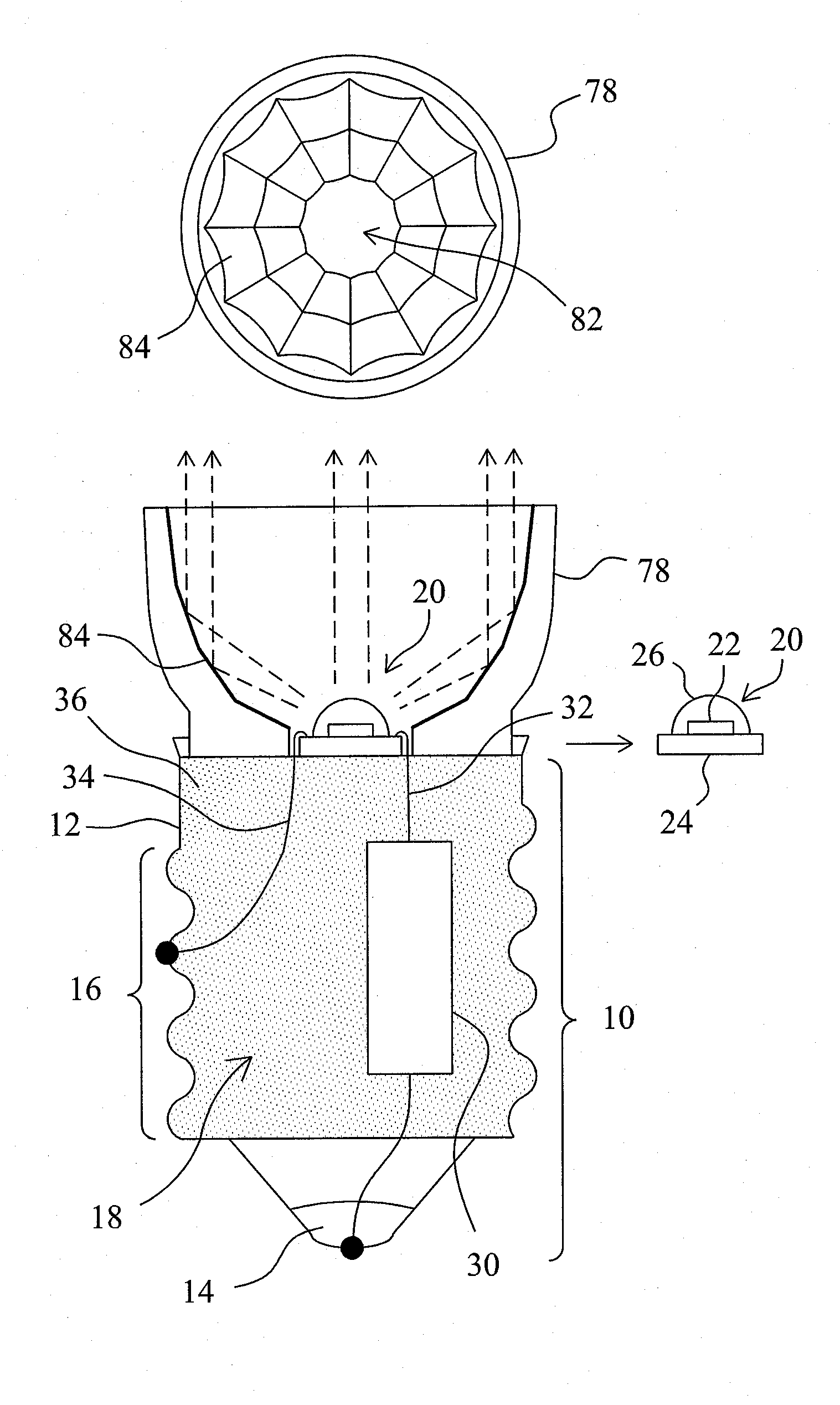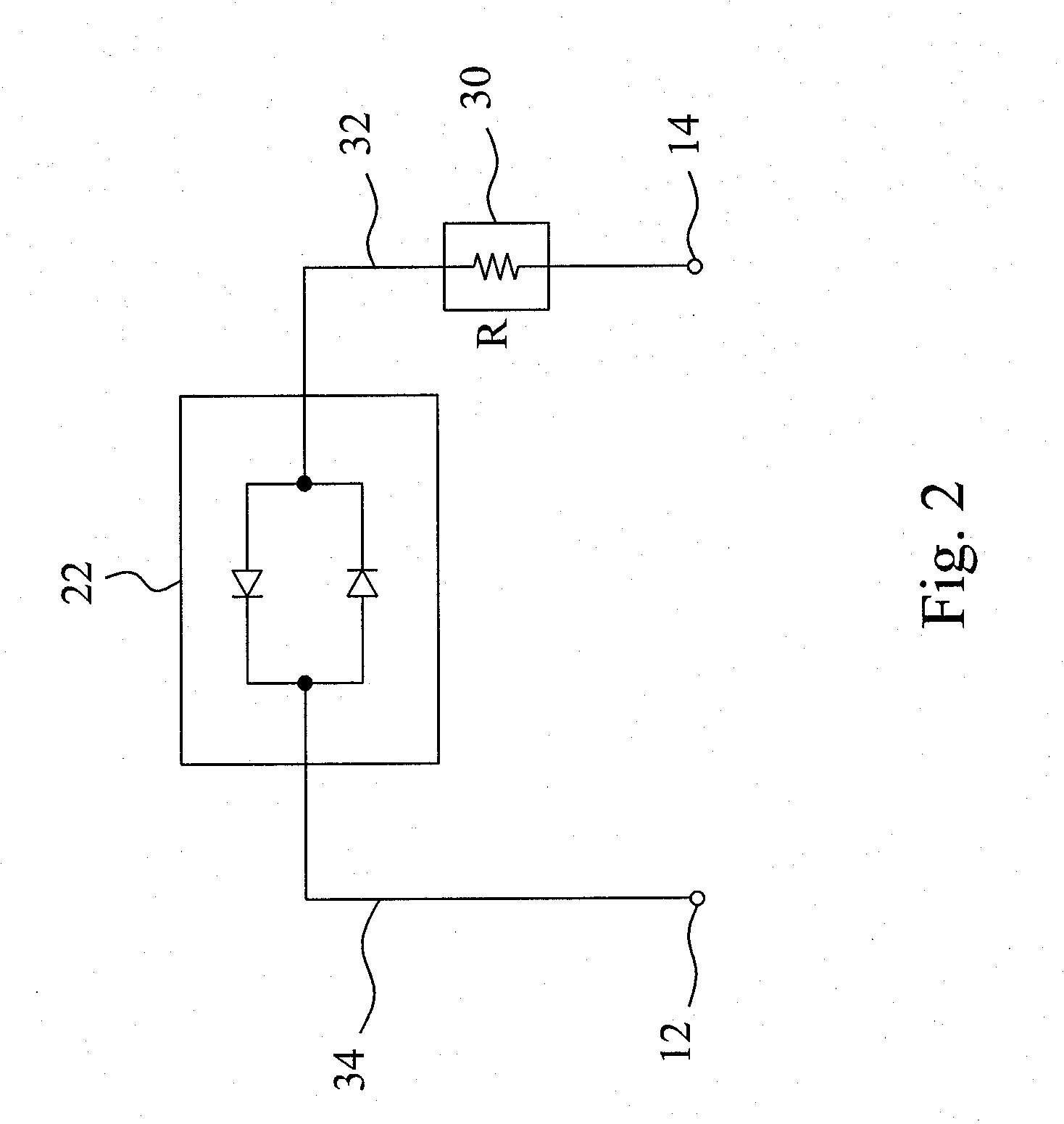Heat dissipation enhanced LED lamp for spotlight
a technology of led lamps and heat dissipation, applied in the field of electric lamps, can solve the problems of short service life, high temperature, short service life, and short service life, and achieve the effect of high power application of led devices
- Summary
- Abstract
- Description
- Claims
- Application Information
AI Technical Summary
Problems solved by technology
Method used
Image
Examples
first embodiment
[0022]FIG. 1 is a cross-sectional view of a first embodiment according to the present invention, in which a standard lamp base 10 for use with a small light bulb is used to accentuate the features of heat dissipation enhancement according to the present invention. The lamp base 10 has two electrodes 12 and 14 for receiving an AC power source. As would be understood by a person of ordinary skill in the art, the electrode 12 is a metal housing which has a spiral-threaded configuration 16 and a cavity 18 therein. In this LED lamp, an AC LED device 20 is used as the filament which includes an AC LED epitaxial chip 22 bounded on a leadframe 24 and covered with an encapsulant 26. As the LED packaging is well-known, the package structure of the AC LED device 20 is not detailed in the drawing for the sake of simplicity. A resistor 30 has one end soldered to the electrode 14 and the opposite end connected to a wire 32 that is soldered to the AC LED device 20. Another wire 34 has its two ends...
fourth embodiment
[0029]FIG. 9 is a cross-sectional view of a fourth embodiment according to the present invention, in which the LED filament includes an AC LED device 20 and a thermally conductive member 50 having a dish at its upper end for the AC LED device 20 to be bounded thereon. Preferably, the lower end of the thermally conductive member 50 has a rod or strip shape. The lower end of the thermally conductive member 50 is buried in a thermally conductive electric insulator 36 filled in the cavity 18 of a lamp base 10, so that the thermally conductive electric insulator 36 establishes a heat dissipation channel for the LED filament to an electrode 12 of the lamp base 10. The height of the AC LED device 20 can be adjusted by adjusting the length of the thermally conductive member 50 into the thermally conductive electric insulator 36. Wires 32 and 34 electrically connect the AC LED device 20 to a resistor 30 and the electrode 12 of the lamp base 10, and the resistor 30 is electrically connected t...
fifth embodiment
[0030]FIG. 10 is a cross-sectional view of a fifth embodiment according to the present invention, in which the LED filament includes an AC LED device 20, and the AC LED epitaxial chip 22 of the AC LED device 20 is packaged with chip resistors 90 in a same encapsulant 26. As shown in the right of FIG. 10, the AC LED epitaxial chip 22 and the chip resistors 90 are attached on a pad 88, and bounding wires 92 and 94 are used to electrically connect the AC LED epitaxial chip 22 to the chip resistors 90 and the chip resistors 90 to the pins 66, whose equivalent circuit is also shown in the drawing. The AC LED device 20 is attached on a thermally conductive electric insulator 36 filled in the cavity 18 of a lamp base 10, and has its pins 66 electrically connected to the electrodes 12 and 14 of the lamp base 10, respectively. In this embodiment, fewer components are used and thus simplify the assembly process of the LED lamp.
[0031]In the above embodiments, depending on practice applications...
PUM
| Property | Measurement | Unit |
|---|---|---|
| rated power | aaaaa | aaaaa |
| resistance | aaaaa | aaaaa |
| rated power | aaaaa | aaaaa |
Abstract
Description
Claims
Application Information
 Login to View More
Login to View More - R&D
- Intellectual Property
- Life Sciences
- Materials
- Tech Scout
- Unparalleled Data Quality
- Higher Quality Content
- 60% Fewer Hallucinations
Browse by: Latest US Patents, China's latest patents, Technical Efficacy Thesaurus, Application Domain, Technology Topic, Popular Technical Reports.
© 2025 PatSnap. All rights reserved.Legal|Privacy policy|Modern Slavery Act Transparency Statement|Sitemap|About US| Contact US: help@patsnap.com



